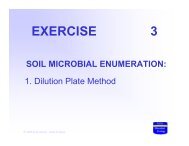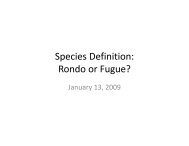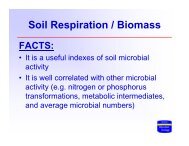Soil Microbial Ecology - Soil Molecular Ecology Laboratory
Soil Microbial Ecology - Soil Molecular Ecology Laboratory
Soil Microbial Ecology - Soil Molecular Ecology Laboratory
Create successful ePaper yourself
Turn your PDF publications into a flip-book with our unique Google optimized e-Paper software.
Page 67<br />
E X E R C I S E 10<br />
SOIL RHIZOSPHERE:<br />
OBJECTIVE:<br />
Isolate and directly observe your desire plant rhizosphere microorganisms using dilution<br />
techniques and compound microscopes<br />
INTRODUCTION<br />
The rhizosphere is defined as the soil volume in close contact with plant roots. Roots<br />
excrete a wide range of organic materials into the soil and these greatly influence the<br />
development of a rhizosphere microbial community. <strong>Microbial</strong> populations differ both<br />
quantitatively and qualitatively from those in the bulk soil. Bacteria populations in the<br />
rhizosphere are often 10-100x higher than in root-free portions of the same soil. The<br />
rhizosphere effect may be expressed in terms of a R/S ratio (rhizosphere population/rootfree<br />
soil population). The rhizosphere also contains a higher proportion of gram<br />
negative, nonsporulating, rod-shaped bacteria, and a lower proportion of gram positive,<br />
nonsporulating rods, cocci, and pleomorphic forms.<br />
Microorganisms in the rhizosphere can have a marked influence on plant growth<br />
(positive or negative). Indeed, the rhizosphere is a complex zone of interactions among<br />
microbial populations and between microorganisms and plant roots. In this exercise you<br />
will use the dilution-plating technique to isolate rhizosphere microorganisms and also<br />
observe microorganisms the root surface by direct microscopy.<br />
METHODS<br />
1. DILUTION-PLATE TECHNIQUE<br />
Obtain a block of soil (approximately 10 cm 3 ) that contains herbaceous plant roots.<br />
Crush the block, with as little tearing of the roots as possible. Remove roots and gently<br />
shake to remove superfluous soil. Place roots, along with adhering soil in weighed flasks<br />
containing 100 ml sterile H 2 0 and glass beads. Shake flasks vigorously for 5 min. on a





